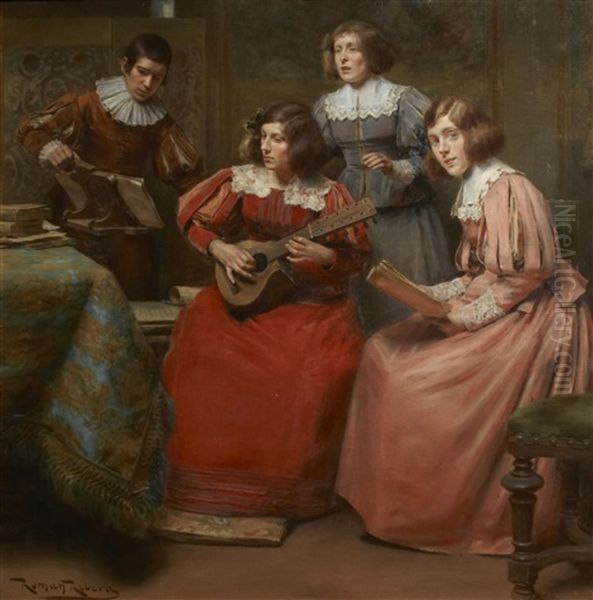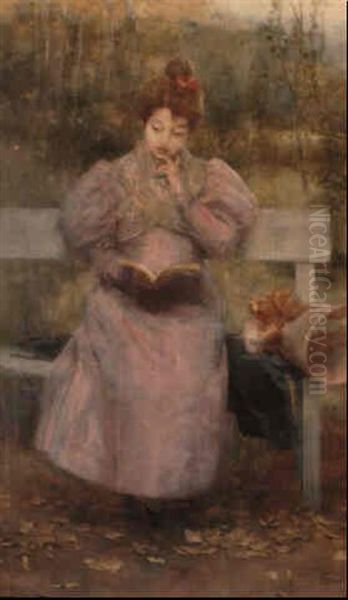
Romà Ribera i Cirera stands as a distinguished figure in Catalan art history, celebrated for his exquisite and detailed portrayals of contemporary high society and his evocative genre scenes. His work, deeply rooted in the realist traditions of the 19th century, offers a luminous window into the opulent world of the bourgeoisie, particularly in Barcelona and Paris, during a period of significant social and artistic transformation. As an artist who navigated the currents of academic training, the profound influence of masters like Marià Fortuny, and the burgeoning international art market, Ribera carved a unique niche for himself, leaving behind a legacy of paintings admired for their technical finesse, narrative charm, and historical insight.
Early Life and Artistic Awakening in Barcelona
Born in Barcelona on either December 13th or 14th, 1848 (though some sources cite 1849), Romà Ribera i Cirera emerged into a city on the cusp of industrial growth and cultural renaissance. His artistic inclinations led him to the prestigious Escola de la Llotja, Barcelona's premier art academy, which had nurtured generations of Catalan artists, including figures like Marià Fortuny himself, albeit earlier. The Llotja provided a foundational academic training, emphasizing drawing and classical principles.
Further honing his skills, Ribera also studied at the private school of Pere Borrell del Caso. Borrell, known for his trompe-l'œil paintings and his departure from strict academicism towards a more direct observation of reality, likely imparted a sense of precision and a focus on capturing the tangible world. This early training in Barcelona equipped Ribera with a strong technical grounding, a keen eye for detail, and an appreciation for realist representation, which would become hallmarks of his mature style. The artistic environment of Barcelona at this time was vibrant, with artists beginning to explore new forms of expression, though academic realism still held considerable sway.
The Roman Sojourn and the Enduring Influence of Marià Fortuny

A pivotal moment in Ribera's artistic development came with his journey to Rome in 1873. Italy, and Rome in particular, was a traditional destination for aspiring artists seeking to immerse themselves in classical art and the legacy of the Renaissance masters. However, for Ribera, the most significant encounter in Rome was with his compatriot, Marià Fortuny i Marsal. Fortuny was by then an internationally acclaimed artist, celebrated for his dazzling technique, vibrant colors, and captivating "preciocista" genre scenes – small, highly detailed paintings often depicting historical or Orientalist themes.
Ribera's interactions with Fortuny were profound. He reportedly discussed his future work plans and sought Fortuny's opinions on his art. Fortuny's influence is clearly discernible in Ribera's subsequent work, particularly in the meticulous attention to detail, the rich textures, and the lively depiction of figures and their environments. Ribera absorbed Fortuny's emphasis on capturing the brilliance of light and color, and the ability to animate a scene with a sense of immediacy. Unlike some of his contemporaries who might have been drawn to the more staid academicism prevalent in Rome, Ribera, under Fortuny's sway, embraced a more dynamic and sensuous approach to painting. This period also saw Ribera exploring themes of social realism, sometimes depicting figures from lower social strata, a thematic concern that Fortuny also touched upon despite his fame for more opulent subjects.
The connection with Fortuny was not merely stylistic; it likely also provided Ribera with insights into the international art market. Fortuny had achieved remarkable success, partly through astute dealers like Adolphe Goupil, and his example would have been instructive for an ambitious young painter like Ribera. Though Fortuny's life was tragically cut short in 1874, his impact on Ribera's artistic trajectory was indelible, shaping his aesthetic sensibilities and his approach to genre painting.
Parisian Triumphs and International Acclaim
Following his formative years in Rome, Romà Ribera i Cirera moved to Paris, the undisputed capital of the art world in the late 19th century. It was here that his career truly blossomed. He arrived at a time when the city was a crucible of artistic innovation, with Impressionism challenging academic conventions. While Ribera did not fully embrace Impressionist techniques, he was undoubtedly aware of these developments, and his palette sometimes shows a brighter, more luminous quality that may reflect this ambient influence.

A significant milestone was his participation in the Paris Universal Exposition of 1878. He exhibited works that captured the sophisticated life of the French capital, and his talent was recognized with a prestigious second-class medal. This success was crucial, as it brought him to the attention of influential figures in the art world, including the renowned art dealer Adolphe Goupil. Goupil & Cie was a powerhouse in the 19th-century art market, representing many successful academic and genre painters, such as Jean-Léon Gérôme and William-Adolphe Bouguereau, and popularizing their work through high-quality reproductions.
Ribera's association with Goupil was instrumental in promoting his art to a wealthy international clientele. He began to specialize in "tableautins," or small, exquisitely finished cabinet pictures, often depicting elegant social gatherings, intimate domestic scenes, and fashionable women. These works, characterized by their refined execution and charming subject matter, catered to the tastes of the burgeoning bourgeoisie. His style during this period drew comparisons with other successful genre painters who chronicled modern life, such as the Frenchman James Tissot, known for his portrayals of fashionable Victorian society, and the Belgian Alfred Stevens, celebrated for his elegant depictions of Parisian women in luxurious interiors. Like these artists, Ribera excelled at capturing the nuances of social etiquette, the richness of fabrics, and the decorative details of opulent settings.
Artistic Style: Anecdotismo and the Elegance of Detail
Romà Ribera i Cirera's artistic style is often categorized within "anecdotismo," or anecdotal painting. This genre, popular in the latter half of the 19th century, focused on depicting narrative scenes, often with a light-hearted or sentimental touch, drawn from everyday life or historical settings. Ribera's approach to anecdotismo was characterized by its sophistication, meticulous realism, and an unerring eye for the subtleties of social interaction.
His paintings are distinguished by their remarkable attention to detail. Every element, from the intricate patterns of a lace fan to the gleam of polished furniture, the texture of silk and velvet gowns, and the delicate features of his subjects, is rendered with painstaking precision. This meticulousness did not result in static or lifeless compositions; rather, Ribera imbued his scenes with a sense of vivacity and immediacy. He had a talent for capturing fleeting moments – a shared glance, a quiet conversation, the rustle of a dress – that lent a narrative charm to his work.
The depiction of contemporary upper-class society was a central theme. He painted scenes of balls, soirées, theatre outings, and intimate moments in lavishly decorated salons. These works provide a fascinating visual record of the Belle Époque, documenting its fashions, customs, and social rituals. His figures, particularly women, are portrayed with an air of elegance and grace, often adorned in the latest Parisian fashions. There's a palpable sense of the cosmopolitan urban life, friendly and sophisticated, that characterized cities like Paris and Barcelona during this era.
Beyond contemporary scenes, Ribera also painted historical genre pieces, often set in the 17th and 18th centuries. These works allowed him to indulge in the depiction of period costumes and settings, further showcasing his technical virtuosity and his ability to evoke the atmosphere of a bygone era. Artists like Ernest Meissonier had popularized this kind of historical genre painting, and Ribera's contributions were well-received.
A subtle but discernible influence of Japanese aesthetics, or Japonisme, can also be noted in some of Ribera's works, particularly in his portrayal of female figures and decorative elements. This was a widespread trend in European art at the time, following the opening of Japan to the West. It often manifested in flattened perspectives, asymmetrical compositions, and an emphasis on decorative patterns, aspects that Ribera might have incorporated to enhance the elegance and exoticism of his subjects. His female figures, while always elegant, sometimes possess a certain enigmatic quality, a "double personality" as some critics noted, perhaps hinting at the complexities beneath the polished surface of high society.
Masterpieces and Notable Works
Among Romà Ribera i Cirera's most celebrated paintings is Leaving the Ball (Sortint del ball), painted around 1901. This work exemplifies his mature style and thematic preoccupations. It depicts a group of elegantly dressed figures descending a grand staircase, presumably after a night of revelry. The play of artificial light on rich fabrics, the varied expressions and postures of the figures, and the overall atmosphere of sophisticated leisure are masterfully captured. The painting is a symphony of textures – silks, satins, furs – and a study in social dynamics, hinting at conversations and connections among the attendees.
Another significant work is A Lady in a Ball Gown. This, and similar portraits or genre scenes focusing on solitary female figures, allowed Ribera to concentrate on the depiction of fashion and the idealized beauty of his sitters. These paintings often highlight the luxuriousness of the attire and the refined setting, emphasizing the status and elegance of the subject.
His oeuvre includes numerous other scenes of social life, such as Salon Scene, After the Theatre, and depictions of intimate domestic moments. His watercolors, too, were highly regarded, as evidenced by his exhibitions, including at the Barcelona Universal Exposition of 1888. These works, while perhaps less formal than his oils, demonstrate his versatility and his continued commitment to detailed observation and refined execution. Many of his works found their way into important private and public collections, including the Museu Nacional d'Art de Catalunya (MNAC) in Barcelona and museums in Madrid. His international appeal also led to his works being acquired by collectors abroad, such as those that ended up in the Myers Museum in the USA.
Return to Barcelona and Later Career
After his successful period in Paris, Romà Ribera i Cirera eventually returned to his native Barcelona, though he maintained connections with the Parisian art world. In Barcelona, he continued to be a prominent figure in the artistic community. He frequently exhibited his work at the Sala Parés, one of the city's leading art galleries, which played a crucial role in promoting Catalan art. His solo exhibitions there were important events, showcasing his latest creations to an appreciative local audience.
His standing in the Catalan art world was formally recognized in 1902 when he was admitted to the Reial Acadèmia Catalana de Belles Arts de Sant Jordi (Royal Catalan Academy of Fine Arts of Saint George). This was a significant honor, affirming his status as one of Catalonia's foremost painters. He was also appointed as a member of the Catalan Museum Committee (Junta de Museus de Catalunya), contributing to the cultural life and heritage preservation of the region.
During his later career, Ribera remained largely faithful to the style and themes that had brought him success. While younger generations of Catalan artists, such as Santiago Rusiñol and Ramon Casas, were spearheading the Modernisme movement, which embraced Symbolism, Art Nouveau, and a more subjective approach to art, Ribera continued to work within a realist framework, albeit one infused with elegance and charm. His art provided a contrast to the sometimes more melancholic or socially critical tones of Modernisme, offering instead a vision of refined pleasure and sophisticated living. He was also a member of the Cercle Artístic de Sant Lluc, an influential artistic society in Barcelona that promoted Christian moral values in art, though its members encompassed a range of styles. Other notable Catalan artists of his era included landscape painters like Joaquim Vayreda and Modest Urgell, who, like Ribera, contributed to the rich tapestry of late 19th and early 20th-century Catalan art.
Interactions and the Broader Art World
Ribera's career was shaped by his interactions with key figures and institutions. His tutelage under Pere Borrell del Caso and his time at the Escola de la Llotja provided his initial grounding. The encounter with Marià Fortuny in Rome was transformative, not only stylistically but likely also in terms of understanding the potential of the international art market, a path Fortuny had navigated with great success alongside artists like his brother-in-law, Raimundo de Madrazo y Garreta.
His collaboration with the Parisian art dealer Adolphe Goupil was crucial for his international career. Goupil's network and his practice of selling high-quality reproductions made artists like Ribera accessible to a wider audience and solidified their reputations. This commercial acumen, while sometimes viewed by critics as prioritizing marketability, was essential for the professional success of many artists in that era, including academic painters like Jean-Léon Gérôme and William-Adolphe Bouguereau, and even artists with more innovative styles who occasionally worked with such dealers.
In Paris, Ribera was part of a vibrant ecosystem of genre painters. His work shares affinities with that of James Tissot, Alfred Stevens, and the Italian expatriate Giovanni Boldini (known for his flamboyant portraits of high society figures), all of whom captured the elegance and dynamism of modern urban life. Jean Béraud, another chronicler of Parisian society, also worked in a similar vein, depicting the boulevards, cafes, and social gatherings of the French capital. Ribera's success in this competitive environment attests to his skill and the appeal of his particular vision.
Legacy and Art Historical Significance
Romà Ribera i Cirera passed away in 1935, leaving behind a significant body of work that continues to be admired for its technical brilliance and its evocative portrayal of a specific social milieu. While he may not have been an avant-garde innovator in the mold of the Impressionists or the later Modernists, his contribution to Catalan and Spanish art is undeniable. He represents a strand of late 19th-century realism that emphasized elegance, narrative, and meticulous craftsmanship.
His paintings serve as valuable historical documents, offering insights into the tastes, fashions, and social customs of the Belle Époque bourgeoisie. They capture a world of leisure and refinement, a world that was undergoing rapid change but still clung to certain ideals of elegance and order. His work can be seen as a bridge between the academic traditions of the mid-19th century and the more diverse artistic landscape of the early 20th century.
While some contemporary or later critics might have occasionally found his work too focused on pleasing a wealthy clientele or lacking in profound social commentary, the enduring appeal of his paintings lies in their beauty, their charm, and their masterful execution. He was a painter who understood his audience and catered to its desire for art that was both aesthetically pleasing and narratively engaging. His dedication to detail and his ability to create luminous, animated scenes place him among the notable genre painters of his time. Artists like Joaquín Sorolla, though more associated with Luminism, also shared a commitment to capturing contemporary life with vibrancy, albeit with a different stylistic emphasis.
In the context of Catalan art, Ribera stands as an important figure who achieved international recognition while remaining connected to his cultural roots. His work, alongside that of contemporaries like Francesc Masriera (another painter of elegant genre scenes and portraits), enriched the artistic panorama of Barcelona and contributed to its reputation as a vibrant cultural center.
Conclusion: An Enduring Vision of Elegance
Romà Ribera i Cirera was a master of his craft, an artist who dedicated his career to capturing the fleeting beauty and refined elegance of his time. From his early studies in Barcelona to his formative experiences in Rome under the shadow of Fortuny, and his triumphs in the competitive art world of Paris, he developed a distinctive style characterized by meticulous detail, rich textures, and a keen observational eye. His depictions of high society balls, intimate gatherings, and fashionable women offer a captivating glimpse into the world of the late 19th and early 20th-century bourgeoisie.
His association with the dealer Adolphe Goupil and his success at international exhibitions underscore his ability to connect with a broad audience. While firmly rooted in the realist tradition, his work possesses a timeless charm that continues to resonate. As a prominent member of the Reial Acadèmia Catalana de Belles Arts de Sant Jordi and a regular exhibitor at the Sala Parés, he played an active role in the cultural life of Barcelona. Romà Ribera i Cirera's legacy is that of an artist who, with consummate skill and an unerring sense of elegance, chronicled an era of opulence and social grace, leaving behind a body of work that is both historically significant and aesthetically delightful.